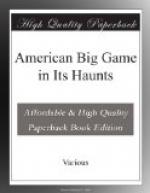It is fully as true of bears as of any other group of large mammals, that our views as to specific distinction are based upon data at present utterly inadequate, for all the zoological museums of the world do not contain sufficient material for exhaustive study and comparison. The present writer has examined many of these collections and has no hesitation in admitting that his ideas upon the subject are much less definite than they were ten years ago. It does appear, though, that in North America four quite distinct types can be made out. First of these is the circumpolar species, Ursus maritimus, the white or polar bear, which most of us grew up to regard as the very incarnation of tenacious ferocity, but which, as it appears from the recitals of late Arctic explorers, dies easily to a single shot, and does not seem to afford much better sport than so much rabbit shooting. The others are the great Kadiak bear (U. middendorfi); the grizzly (U. horribilis), and the black or true American bear (U. americanus). The extent to which the last three may be subdivided remains uncertain, but the barren-ground bear (U. richardsoni) is surely a valid species of the grizzly type. The grizzlies and the big Alaska bears approach more nearly than americanus to the widespread brown bear (U. arctos) of Europe and Asia, and the hypothesis is reasonable that they originated from that form or its immediate ancestors, in which case we have the interesting series of parallel modifications exhibited in the two continents, for the large bear of Kamtschatka approaches very nearly to those of Alaska, while further to the south in America, where the conditions of life more nearly resemble those surrounding arctos, these bears have in the grizzlies retained more of their original form. Whether or not the large Pleistocene cave bear (U. spelaeus) was a lineal ancestor is questionable, for in its later period, at least, it was contemporary with the existing European species. The black bear, with its litter-brother of brown color, seems to be a genuine product of the new world.
Many differential characters have been pointed out in the skulls and teeth of bears, and to a less extent, in the claws; but while these undoubtedly exist, the conclusions to be drawn from them are uncertain, for the skulls of bears change greatly with age, and the constancy of these variations, with the values which they should hold in classification, we do not yet know.
* * * * *
It is not improbable that the reader may leave this brief survey with the feeling that its admissions of ignorance exceed its affirmations of certainty, and such is indeed the case, for the law of scientific validity forbids the statement as fact, of that concerning which the least element of doubt remains. But the real advance of zoological knowledge must not thereby be discredited, for it is due to those who




